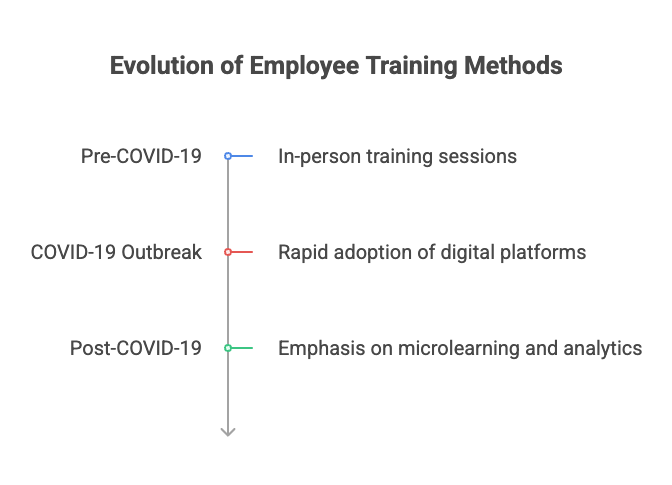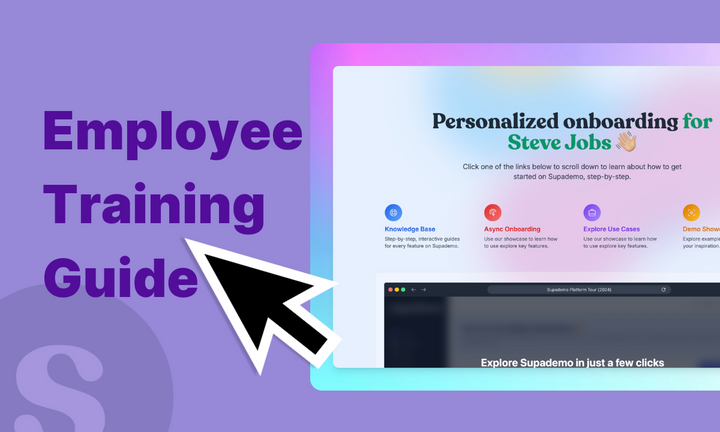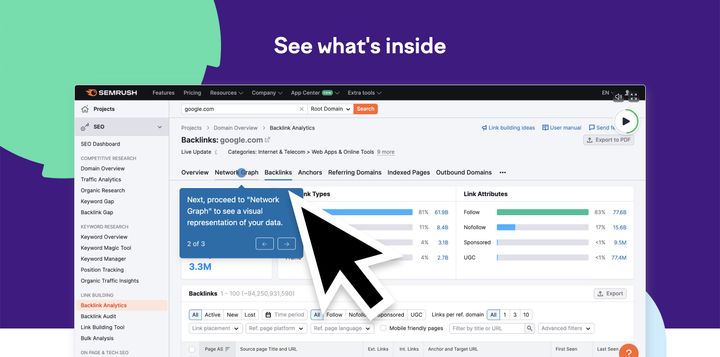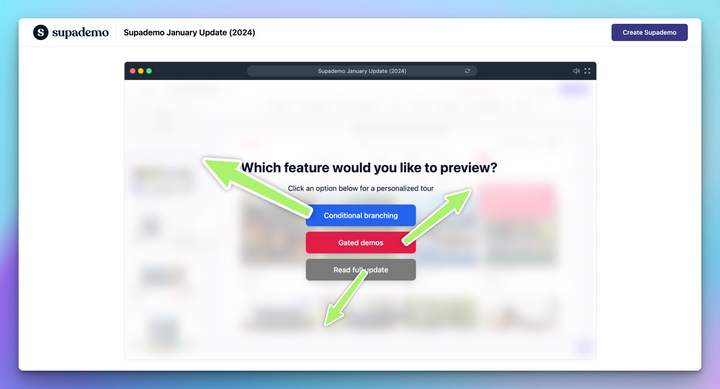What is employee training?
Employee training is the process of equipping employees with the knowledge, skills, and tools they need to perform their roles effectively.
It covers everything from employee onboarding videos and compliance to upskilling, leadership development, and tool-specific learning. Effective training not only improves individual performance but also boosts team productivity, engagement, and retention.
With modern methods like interactive demos and self-paced learning, companies can deliver impactful training that adapts to diverse learning styles and remote environments. Ultimately, employee training is a strategic investment that empowers teams to grow, adapt, and contribute more meaningfully to business success.
Employee training: History and background
Employee training originally centered on in-person instruction. Companies gathered employees in conference rooms for lectures and workshops. While effective, this approach created scheduling challenges and limited scalability.
Technology introduced Learning Management Systems (LMS) that supplemented traditional methods with online modules. Cloud-based platforms later enabled organizations to deliver employee training anywhere, anytime, reaching distributed teams efficiently.
How COVID-19 accelerated modern training approaches

COVID-19 forced organizations to abandon in-person sessions overnight, rapidly adopting digital platforms.
Modern employee training now emphasizes microlearning—short, focused modules accessible on-demand. Companies prioritize flexible, self-paced learning that fits employee schedules.
Today's platforms incorporate advanced analytics, allowing organizations to track engagement and measure ROI effectively.
| Aspect | Pre-COVID | Post-COVID |
|---|---|---|
| Delivery | In-person classroom | Digital-first, remote |
| Scheduling | Fixed schedules | Flexible, on-demand |
| Format | Instructor-led | Interactive, microlearning |
| Focus | Job-specific skills | Digital skills, adaptability |
| Analytics | Basic tracking | Advanced metrics |
Why employee training is critical for business success
Employee training delivers measurable improvements across key business metrics, making it a strategic necessity for competitive organizations.
Here are some more numbers to crunch on regarding the importance of employee training.
| Business Impact Area | Key Statistic |
|---|---|
| Profitability | 21–24% higher when employees receive training |
| Productivity | 17–37% increase due to structured training |
| Income per Employee | 218% higher with comprehensive training programs |
| Retention | 94% would stay longer if company invests in learning |
| New Hire Retention | 82% improvement with structured onboarding |
| Sales Performance | 57% increase with increased training investment |
| Engaged Employees | 47% more likely to be engaged with access to learning |
1. Impact on productivity and performance
Effective employee training directly boosts productivity through:
- Faster task completion - Skilled employees work more efficiently
- Reduced errors - Proper training minimizes costly mistakes
- Quick adaptation - Workers adjust faster to new technologies
- Higher quality output - Confident employees deliver better results
2. Employee retention and engagement benefits
Training programs create significant retention advantages:
- Lower turnover - Employees with development opportunities stay longer
- Increased satisfaction - Workers feel valued when companies invest in growth
- Higher engagement - Clear development paths boost motivation
- Better teamwork - Well-trained teams collaborate more effectively
3. ROI and business outcomes
Employee training generates substantial financial returns:
- Cost savings - Reduced turnover and fewer errors lower expenses
- Revenue growth - Trained sales teams close more deals
- Customer satisfaction - Knowledgeable employees provide superior service
- Competitive advantage - Skilled workforces adapt quickly to market changes
Companies with comprehensive training programs consistently outperform competitors in profitability and market position, creating essential agility for long-term success.
Core types of employee training programs
Organizations need diverse training programs to address different skill gaps and business requirements. Each type serves specific purposes and contributes to overall workforce development.
| Training Type | Overview | Implementation Tips |
|---|---|---|
| Onboarding and Orientation | Introduces new employees to company culture, policies, and role expectations. Covers company history, organizational structure, job responsibilities, benefits, and technology systems. Sets foundation for long-term success and engagement. | • Create standardized checklists for consistent experiences • Assign dedicated mentors to new hires • Use interactive formats like videos and gamification • Schedule regular check-ins during the first 90 days |
| Compliance and Regulatory | Ensures employees understand legal requirements and company policies. Covers anti-harassment policies, data privacy protocols, industry regulations like HIPAA or GDPR, and ethics codes. | • Use real-world scenarios and case studies • Schedule regular refresher sessions • Make content easily searchable for reference • Partner with legal teams for accuracy |
| Technical and Job-Specific Skills | Develops specific competencies employees need for their roles. Focuses on software proficiency, industry methodologies, equipment operation, and certification preparation. | • Conduct skills assessments to identify needs • Offer multiple learning formats (videos, simulations, practice) • Create role-specific learning paths • Update content as technology evolves |
| Leadership and Management Development | Prepares employees for management roles and helps existing managers improve effectiveness. Develops team building, performance management, strategic thinking, and communication skills. | • Identify high-potential employees early • Use experiential learning through stretch assignments • Provide coaching and mentoring support • Measure effectiveness through employee surveys |
| Soft Skills and Interpersonal | Develops communication, collaboration, and emotional intelligence capabilities. Covers active listening, teamwork, problem-solving, time management, and emotional intelligence. | • Use interactive workshops over lecture-style sessions • Incorporate role-playing and real scenarios • Provide ongoing reinforcement through microlearning • Connect development to performance reviews |
| Safety and Workplace | Protects employees from workplace hazards and ensures regulatory compliance. Covers hazard identification, protective equipment usage, emergency procedures, and injury prevention. | • Conduct regular safety drills and practice sessions • Use visual aids and hands-on demonstrations • Make safety training part of daily routines • Track safety metrics to improve programs |
| Diversity, Equity, and Inclusion | Promotes inclusive workplace cultures and helps employees understand unconscious bias and cultural differences. Covers bias recognition, cultural competency, inclusive communication, and microaggression prevention. | • Ensure leadership participation and visible commitment • Use facilitators with DEI expertise • Create safe spaces for honest dialogue • Follow up with ongoing reinforcement and accountability |
Modern employee training methods and delivery
Organizations now have access to various delivery methods that improve engagement, flexibility, and learning outcomes.
Here are the most effective approaches for modern employee training.
1. E-learning and digital platforms
Digital adoptions platforms provide scalable solutions for distributed workforces. These platforms offer centralized content management, progress tracking, and interactive learning experiences.

Implementation Tips:
- Choose platforms that integrate with existing HR systems
- Ensure mobile compatibility for flexible access
- Use analytics to track engagement and completion rates
- Create simple, user-friendly interfaces
2. Blended learning approaches
Blended learning combines online content with traditional classroom methods.
This employee training approach uses self-paced online modules alongside instructor-led sessions, workshops, or mentoring programs.
This means combining interactive demos with, let's say, live sessions hosted on Zoom, for example.
Benefits include:
- Flexibility for employees to learn at their own pace
- Face-to-face interaction for complex topics
- Cost-effective scaling of training programs
- Better knowledge retention through multiple formats
Implementation Tips:
- Use online modules for knowledge transfer, in-person sessions for practice
- Balance online and offline components based on learning goals
- Provide clear connections between digital and traditional elements
- Schedule regular check-ins with instructors
3. Interactive Demos
Interactive demos allow employees to practice with actual software interfaces in a safe environment. This hands-on approach increases retention and builds confidence.
These also aid in microlearning and just-in-time training.
It helps deliver employee training in small, focused segments that fit busy schedules. Just-in-time training provides information when employees need it, rather than requiring them to remember earlier content.
An interactive demo is a hands-on, guided product walkthrough that lets employees learn by doing—making training faster, more engaging, and easier to retain.
Here's an example of what an interactive demo looks like:
Employees can easily click through this self-paced training module and learn while doing rather than just watching an unegaging 30 min video or reading long PDF.
Benefits of interactive demos:
- Practice real workflows without affecting live systems
- Learn by doing rather than just watching
- Repeat sections as needed for mastery
- Build confidence before working with actual systems
Implementation Tips:
- Use interactive demos for software and process training
- Create scenarios that mirror real work situations
- Allow learners to repeat sections for mastery
- Combine demos with assessments to verify understanding
- Update demos when systems change
Consider these factors when selecting employee training methods:
✅ Learning objectives and content complexity
✅ Employee preferences and technical skills
✅ Budget and resource constraints
✅ Timeline for implementation
✅ Measurement and tracking requirements
Most organizations benefit from combining multiple methods rather than relying on a single approach. Start with one method, measure results, then gradually add others based on what works best for your team.
Tool suggestions for all your employee training requirements
| Training Method | Enterprise Solutions | Mid-Market Options | Budget-Friendly Tools |
|---|---|---|---|
| E-learning Platforms | LearnUpon, Cornerstone OnDemand, SAP SuccessFactors | TalentLMS, Docebo, iSpring Learn | Moodle, Google Classroom, Coursera for Business |
| Blended Learning | Adobe Connect, Canvas, Blackboard | Zoom, Microsoft Teams, BigBlueButton | Google Meet, Jitsi Meet, OpenEduCat |
| Microlearning | Axonify, Degreed, Cornerstone Grovo | EdApp, Bite-sized Learning, Mindtickle | Kahoot!, Quizlet, Anki |
| Interactive Demos | Supademo, Articulate Storyline 360, Adobe Captivate | Supademo, Camtasia, Loom | Supademo, OBS Studio, ActivePresenter |
Choose tools based on your organization's size, budget, technical requirements, and integration needs with existing systems.
Best practices for effective employee training
Successful employee training requires strategic planning and ongoing optimization to maximize ROI and achieve meaningful learning outcomes.
Needs assessment and program design
- Conduct employee surveys and manager interviews to identify specific skill gaps
- Analyze performance data and error rates to pinpoint improvement areas
- Set clear, measurable learning objectives that connect to job performance
- Create modular content that can be customized for different roles
- Establish realistic timelines that balance business needs with learning effectiveness
Creating engaging and relevant content
- Use real workplace scenarios and actual company examples to increase relevance
- Include multiple content formats like videos, interactive simulations, and hands-on practice
- Break complex topics into 10-15 minute segments to maintain attention
- Add quizzes and interactive elements throughout content to boost engagement
- Update content regularly to reflect current processes and best practices
Measuring training effectiveness
- Track completion rates and use pre- and post-training assessments to measure knowledge gains
- Monitor job performance metrics 30, 60, and 90 days after training completion
- Measure business outcomes like productivity improvements, reduced errors, or increased sales
- Calculate ROI by comparing training costs to measurable business improvements
- Use focus groups to gather detailed feedback on training effectiveness
Building a continuous learning culture
- Encourage peer-to-peer knowledge sharing through mentoring programs
- Provide access to external learning resources like online courses and industry publications
- Include learning goals in regular performance reviews and career development discussions
- Give managers training on how to coach and develop their team members
- Allocate dedicated time for learning activities during work hours
Current trends shaping employee training
Modern employee training and employee training software are evolving rapidly with new technologies and changing workforce expectations. These trends are reshaping how organizations deliver learning experiences.
1. Personalized learning experiences using interactive demos
- Adaptive learning platforms adjust content difficulty based on individual progress and performance levels
- Interactive demos like Supademo create customized walkthroughs that match specific job roles and skill levels
- AI-powered systems recommend relevant training modules based on employee behavior and learning patterns

- Personalized learning paths allow employees to focus on skills most relevant to their career goals

2. AI and technology integration
- Chatbots provide instant answers to training questions and guide learners through complex processes
- Machine learning algorithms identify knowledge gaps and suggest targeted training interventions automatically
- AI-powered content creation tools generate personalized quizzes, assessments, and learning materials at scale
- Virtual reality simulations create immersive training experiences for high-risk or complex scenarios
3. Mobile-first training solutions
- Responsive design ensures training content works seamlessly across smartphones, tablets, and desktop devices
- Mobile apps enable employees to access employee training tools during commutes, breaks, or downtime
- Push notifications remind learners about upcoming deadlines and suggest relevant micro-learning modules
- Offline capabilities allow training access in areas with poor internet connectivity
4. Collaborative and social learning
- Peer-to-peer learning platforms connect employees across departments to share knowledge and best practices
- Discussion forums and chat features enable real-time collaboration during training programs
- User-generated content allows experienced employees to create and share training materials with colleagues
- Social recognition systems highlight learning achievements and encourage continued participation in training programs
These trends reflect the shift toward more flexible, engaging, and effective employee training that meets modern workforce expectations while delivering measurable business results.
Future-proof your employee training with Supademo
Employee training has evolved from static, classroom-based sessions to dynamic, tech-driven experiences tailored to today’s workforce. Companies that invest in modern training approaches see improvements in productivity, retention, and overall performance.
The most effective strategies blend multiple formats—from onboarding and compliance to leadership and technical training.
Interactive demos, like those built with Supademo, are transforming how teams learn. They’re quick to create, easy to update, and support different learning styles—making them ideal for both remote and in-office teams.
Ready to level up your training? Sign up today.




